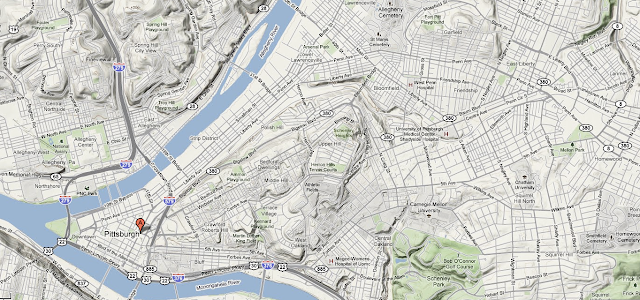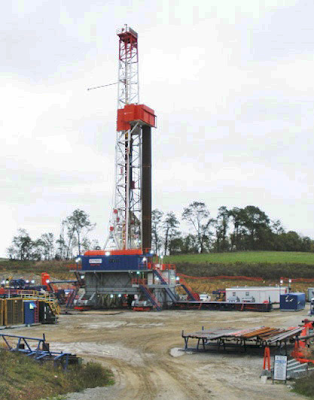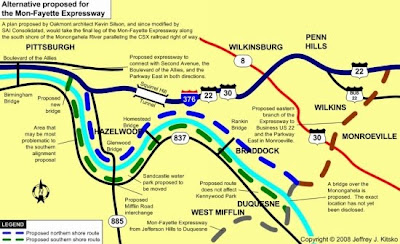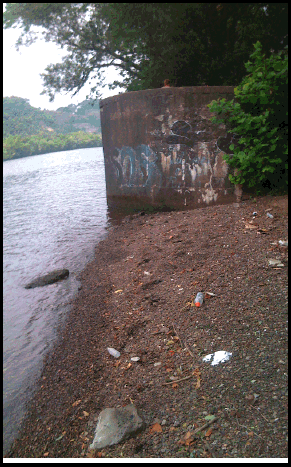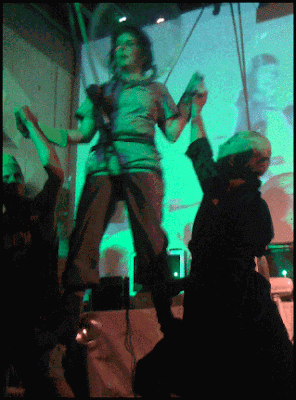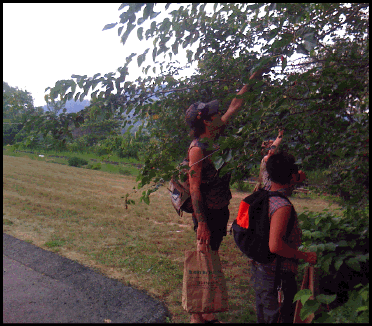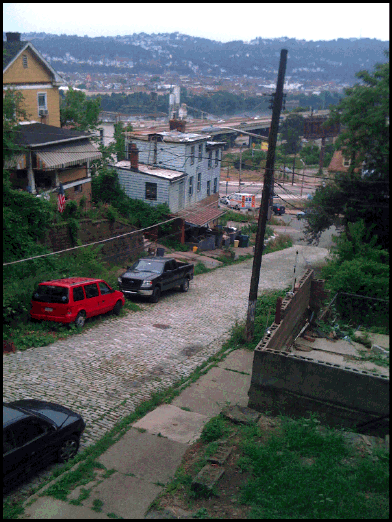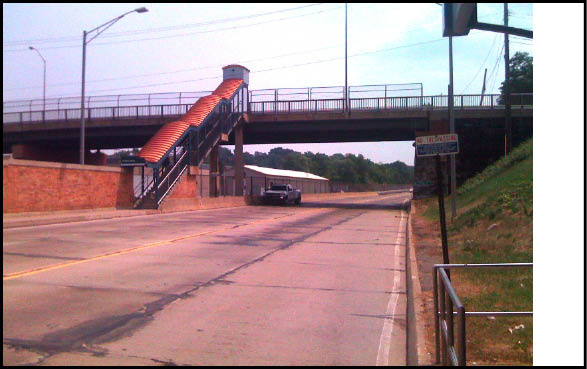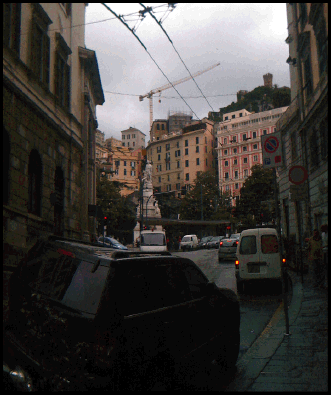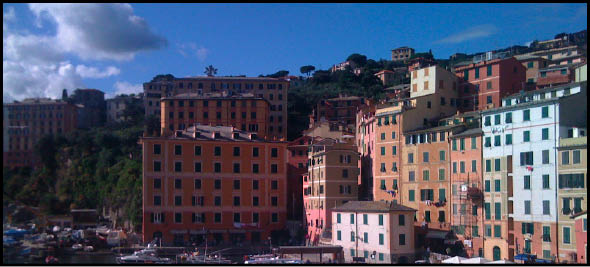| Problems | Unique differentiations of PGH |
| Dependance of/use of cars: Poor public transport Lack of pedestrian passageways poor road quality Lack of parks / Public space. Lack of access to waterways Air / soil quality Lack of local economic infrastructure |
Topography Neighborhood locality Geographic location Waterways Neighborhood Diversity The University |
Pittsburgh, it’s topography is a patchwork of steep hills and a confluence of rivers. These two unique elements act as a baseline to the layout and social relationships in this city. The typical American kind of development of seemingly limitless sprawl cannot work with such fluid and playful terrain. This is why Pittsburgh offers an opportunity for Americans to rethink Urbanism with the possibility to articulate an architecture based on situated knowledge and locality.
In terms of the current state of the city, perhaps the lessons are obvious and I can observe well enough all the broken parts and draw conclusions of how they got there. However what is interesting is to notice new forces at play in the city that have come from the margin to center. These things can act as signifiers of what possibilities can take shape in the future. It is a sketched map with a vision of elsewhere made by cartographers outside the dominant culture.
A city is the conjunction of public social space and private realms. Pittsburgh has suffered the disinvestment in both.
In the way of changes against the tides of this downward trend, pressure has come from two particular points. One is “gentrification”, the other the general spectrum of the activist community. Both interlock their focus on the issue of quality of life, however they greatly diverge on the values of how and what that looks like. I would approach the issue from the perspective of the latter.
My intention is to see how a city like Pittsburgh can A fulfil the capacity to be a place where innovative approaches to living in a more ecologically/socially connected, and resilient way can take form. I hope to trace lines as to how the existing trends and social patchwork can grow into fulfilment of the said goals.
My first night in town I met a couple in Polish hill who was really exited about living in Pittsburgh again after having lived in Chicago and NYC in the past. One was a dancer and the other had his own design & build firm. They were both in their early thirties and originally grew up here. The attitude I got from them was that things were going up and up. This was an interesting example of home town pride that I did not expect. I felt as though it was a creative kind of desire, that by holding the narrative of improvement and mobility it enabled them to manifest it. Their engaged attitude also poured out into them being involved in sewing the social fabric. The guy would have times in the week where he would open up his shop for other folks to use. The woman was involved with a performance arts space.
It takes a leap of faith to invest yourself in Pittsburgh against the history and the odds. However there are several people I met and know who are in Pittsburgh because they have hope that this place, in it’s condition, offers them something they cannot find elsewhere.
The things that have improved livability of Pittsburgh have come not from city hall but from local efforts. If anything, Pittsburgh is an example of how the actions of those taken in city hall and top-down models was not in the benefit or best interest of the residents of Pittsburgh. Politicians and connected hacks spent billions on the recent development projects of the stadium, the convention center and the like while the city cuts bus service and cannot afford to maintain its streets.
Currently Pittsburgh is at a threat to Gas drilling within city limits.
“Drilling for and extracting the gas could bring billions of dollars into the state and create thousands of jobs, according to industry officials. But getting the gas out of the shale requires drilling companies to pump millions of gallons of water, sand and toxic chemicals into the shale under tremendous pressure to fracture, or “frack,” the shale formation and release the gas. “
The fact that drilling in urban areas is still up for debate is shocking. In the words of a nearby farmer affected by the drilling: “I think clean water is more important than gas.” Because representative government cannot be trusted in regards to preventing this from occurring, the people of Pittsburgh have to fight against the odds to ensure their own health and safety. The city hall meeting I attended set the dialogue not in terms of if this will happen, but of how to do it according to regulations. The present policy leaves no jurisdiction to the local officials to have say on if they want to have this happen in their area or not. The ability of the Pittsburgh community come together to win this battle could be an empowering example of the power of community action. Grassroots politics would gain legitimacy within the policy making sphere and would act as a testing ground for further action in regards to the residents asserting their power.
The other issue is the proposed construction of the Mon Valley Expressway. The Project’s developers say the roadway will foster business development in the Mon Valley, encourage re-use of abandoned industrial sites and create a vibrant corridor connecting Monroeville to Pittsburgh International Airport. “Individual mobility is one of the high marks of the development of a vibrant economy,” said Joe Kirk, executive director of the Mon Valley Progress Council in Monessen. “It’s about mobility, even more than access.”
Opponents claim the projects are antiquated concepts that will encourage businesses to migrate farther from Pittsburgh, devastate the communities and environment in its footprint and stifle debate on alternative transportation such as a light-rail network. The roadway in general would harm lower-income urban dwellers to benefit higher-income suburban commuters. The Y leg would run through the town of Braddock. Many would say that the concept of building highways within American cities or to reinvigorate them peaked 40 to 50 years ago.
This is yet another milestone for the Pittsburgh community to defeat. They mayor of Braddock as well as other local activists have spoken out against the proposed development claiming there are alternative options for rejuvenating the affected areas. Organizing around this issue could spur dialogue around transportation options and could be another potential turning point in shifting the paradigm from cars and highways to people centered holistic transportation and lifestyle options.
These series of conflicts epitomize a rift between two worlds, their outcome will signify the direction and momentum in the future of Pittsburgh.
Water, is perhaps the biggest deciding factor in the location and use of a city. To look at Pittsburgh in terms of it water is to encounter a slight paradox. Like in many industrial cities the water was a way to transport goods and get rid of waste. In this sense the presence of water is crucial. Culturally, humans have a long history with water in that it fulfils some deep seated need in us and acts as a socially healthy element in a living space. Presently, human access to water is limited in Pittsburgh. Downtown tranquil access is hindered by the elevated mazes of highways that line the curve of the water’s edge. Further up stream, there is a physical barrier of having poured concrete and walls that keep you from getting to the water.
I think that Pittsburgh has a tremendous asset by being located at the confluence of two rivers. A different relationship is possible with these riparian zones. Presently the city seems to treat them as problem areas by way of keeping from people as far from the water as possible. As in many other cities with bordering bodies of water, these could be ecologically diverse ecosystems that also serve as centers of social gathering. Parks adjoining water often are the social centers of cities. Despite all this, there are some improvised areas that allow one closer to the water. I’ve seen people fishing over what ever near overhangs exist. Several areas have been slightly altered in the past couple of years to allow pedestrian access closer the water. People were quick to find ways down by eroding small paths that lead down. There is a rope swing that people go out to jump in on hot summer days.
A critical aspect of city living is access to recreational space, mainly Parks. PGH has some very large parks in the parts of town closer to the university but given the dividing quality of the hills those parks are less accessible by those not living in those regions. Aside from the large formal parks, there is little in the way of neighbourhood areas with dedicated green space. In Lawrenceville, a region that lacks green spaces, people found that the Cemetery is just as good if not better as a green space. Despite everything, it serves as a social meeting point/ hang out spot for many people. Many of the urban farming projects also sought to fulfil this need by creating sanctuary spaces as a part of their gardens in place of the empty lots of land around the city. At the moment, this movement seems to be more the product of individuals choosing to create something in a underutilized hillside, or median.
Biking in Pittsburgh is not for the faint of heart, the bicycle map advices strong caution and warrants against travelling on certain roadways on a bike due to exclusionary vehicle centred layout and roadway design. The city has done nothing to improve this, the common bikeway: Penn Ave still has lanes that are 10ft wide (standard highway size), it is full of pot holes and has no designated bike lane or markings.
The organization Bike-Pittsburgh has published a bike map with safer biking options and installed bicycle racks in certain neighbourhoods. They are also working on a project called “Complete streets” “Complete Streets is the idea that the streets of our cities and towns ought to be for everyone, whether young or old, motorist or bicyclist, walker or wheelchair user, bus rider or shopkeeper. But too many of our streets are designed only for speeding cars, or worse, creeping traffic jams. They’re unsafe for people on foot or bike — and unpleasant for everybody.” This initiate gets at the heart of what plagues Pittsburgh streets, lack of accessibility. In order to evolve from car culture we must provide people with options that encourage them to explore the alternatives.
The organization Construction junction provides cheap and reusable construction materials. Free ride (bicycle shop) offers a space to work on bicycles. The farmers market between Liberty ave and Penn ave provide an outlet for local farmers and encourage healthy food in the city. They are working on the system to accept Food Stamps.
The alternative/activist community is doing a lot to bring together like minded individuals and co-create a vibrant social atmosphere, below is a photo of a DIY “ taco truck”(Center right) basically a back yard with an entrance from the ally for folks to come and eat.
The online forum http://nevertellmetheodds.org/ acts as an event board and serves as a communication portal for radical/alternative/underground events. Local humor and even poetry get posted up there weaving a cultural fabric that brings together people on a pulse of their social climate.
There is a group organizing around alternative medicine and localized knowledge of medicinal and eatable plants. They do plant walks and harvests in and around Pittsburgh. They also make their own forms of medicine as wells as food from the harvest. This provides a local and self supporting alternative to the US health care system and a resource in the neighbourhood.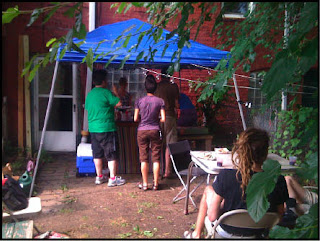 There is also fertile ground for experimental arts/music in Pittsburgh, because there is a lack of infrastructure for a cultural base, in some ways the ground is cleared for people to put on events and shows that they have an idea for, make ad hoc events seem to occur. Many cities have a more exclusive, less accessible atmosphere that is less interested in taking risks to book something they have never tried before, where as here there seemed to be a lot more of a “let’s try doing this thing and see what happens” type of attitude. I went to a variety show staged in someone’s basement/studio that was nothing short of danger and fun in the most visceral of forms. But it was not just weekend entertainment found at a bar, below all the fun and games there was serious philosophy and social criticism going on surrounding the interaction between humans and their technology.
There is also fertile ground for experimental arts/music in Pittsburgh, because there is a lack of infrastructure for a cultural base, in some ways the ground is cleared for people to put on events and shows that they have an idea for, make ad hoc events seem to occur. Many cities have a more exclusive, less accessible atmosphere that is less interested in taking risks to book something they have never tried before, where as here there seemed to be a lot more of a “let’s try doing this thing and see what happens” type of attitude. I went to a variety show staged in someone’s basement/studio that was nothing short of danger and fun in the most visceral of forms. But it was not just weekend entertainment found at a bar, below all the fun and games there was serious philosophy and social criticism going on surrounding the interaction between humans and their technology.
The Landslide landslide community farm (Bottom right) is an interesting example of alternative infrastructure that describes itself a Hill District based farm dedicated to providing a free source of healthy food to the community. We are committed to sustainability and are working with the concepts of permaculture. We hope to be a neighbourhood run project that focuses on education and as mutual aid.
They took advantage of a region previously affected by a landslide that opened up sloped unbuilt terrain. By building a loose community at a dead end street their aim is to create an alternative way of living in urban environments with a focus on food security. They are in the process of reclaiming more of the hillside for growing food.
There is a place I would call the “East Liberty Whole foods contingent” a fairly recent development project that represents gentrification’s approach to meeting some of the needs urban living by providing a diverse array of shops, bars and restaurants. The end result resembles nothing short of a Euro-style shopping mall. The scale still does not feel walkable in most of the places. Above all it is another development project, not one defined by the initiatives of the surrounding residents.
Valerie Taing, a social organizer from Pittsburgh said her idea of the ideal city is “A city where everything is controlled by, developed by, and meets the needs of the people that live there, and I get to sit on a porch and build with elders.”
The politicians and economic developers are chasing after the same tired model many other US cities are all to ready to apply; that of Revitalization of the city for the Creative industry/class. Main streets becoming bars restaurants and cafes. The critique of this is beyond scope however it raises the question of how suitable is this model for a city like Pittsburgh?
The topography of this city is inseparable from it’s experience and daily life. Given that the city is sparsely populated compared to it’s previous time and all this talk of urban planning initiatives, it brings into question issues of the use of space, zoning, transportation and greenspace.
Steep terrain has fostered locality. Each neighbourhood marked of by it’s hills has held its own cultural identity, social networks and village like feel. This has helped stabilize these neighbourhoods against the ruthless policies of urban renewal(top down modernist schemes) in the 60’s sustain their economy in the downturn of the 70’s and 80’s
Such topography requires frugal and shrewd city design in order to optimise and promote comfortable life in such places. Tools in the toolbox for this are: density, conscious placement of services, and accessible transportation. Pittsburgh falls short in this in most locations, roads with no shoulder Bigelow blvd (utter horror) unreliable busses and lack of grocery stores indicates this. The gentrification happening in Pittsburgh tries to address this problem, but fails at the heart of it by not meeting the diversity of needs in a localized neighbourhood. You can’t get your shoes fixed at a cafe/bar. It still leaves people driving to places elsewhere. The solution built in Pittsburgh is a recipe stolen from a book that does not apply to the unique differentiations that make up Pittsburgh.
An interesting case study is the Bus highway running parallel to the train tracks located in the valley. (Above) There is a highway designated solely for buses and emergency vehicles. To bike to the same locations one has to climb over a ton of hills, why could there not be a bike/pedestrian lane here? Having this be a bus is also quite strange, there are already tracks for trains, this could have functioned much smoother had there been a light rail track put in. Despite the empty highway the bus was eight minutes late. I imagine it is possible to find a creative reuse of such a space.
If density is a goal for cities of mountainous terrain, Pittsburgh would benefit from creating the necessary elements of urban living such as mixed use live/work zones, this would requiring people to travel vast distances and to maintain a costly highway system.
In contrast, a small village on the mountainous coast of Italy(below) is perhaps a case study of an approach to city building that takes into account it’s terrain and uses it to an advantage. The main thing that works about this village is that it is walkable, which creates a totally different sense of scale to the place. In some ways this town looks a lot more urban then many parts of LA.
What is workable about Pittsburgh? In the social/geographic space there is a plethora of avenues in which innovative localized approaches to living, expression and meeting one’s needs can take shape. The low cost of living and the relative abundance of space are the most enabling elements to this direction.
There is a lot to be done in the realm of the current sustainability trend that is sweeping the nation. In many of the hot beds for this, Green capitalism as appropriated the movement and rearticulated the goal of sustainability to meeting it’s own hegemonic ends. However in places where there is still a lack of that process, the radical community can have greater control over expressing these initiatives in ways that are conflictual to the dominant order as well as provide a living example of the options on the table.
As in many rustbelt regions the demographic of people are in a different position then the swarms of professionals that live in S.F. LA or NYC. They can take or leave the merits of smaller footprint living where as poorer populations have direct gain in implementing an alternate paradigm that fosters sharing of resources and localized creation of capital.
However, what is in question in this regard is the power of socialization. In conversation, someone said in an example that if Pittsburgh had a choice of having the Pittsburgh steelers (football team) move out of the area in return for never having to work for a boss they would choose to keep the steelers.
This brings a couple questions
Would the results of Pittsburgh’s current fate be the different if residents had more control over their city & neighborhoods, as opposed to the authorities?
Would they reify the order of the state because of their cultural conditioning?
What influence do outside forces have on the situation, globalization, national policy, etc?
How do those forces hinder or promote autonomy?
Slowly, a map is woven, it gives us a layer over the current world we know. It is an upsurge in culture that is evermore interested in localized self-governing strategies to create and address urban issues. Notions of community, ecology and local interdependence form a net of ideas that pose a challenge to the dominant paradigm of our culture. Local resilience and self-organization is inherently anti-capitalist. It’s about collaboration and sharing power and less about competing and usurping. The implementation of alternative living options boils down not to the merits of their practically but their ideological compatibility and integration to the globalized hegemony.
We have seen what centralized top-down models have brought us, the alienated carelessness of it all. Now it’s up to us to empower ourselves and each other. To take ownership of streets and neighbourhoods To build a network of local power.

